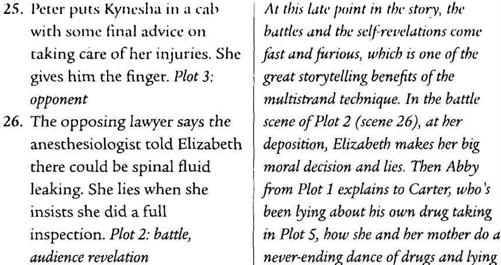The Anatomy of Story (55 page)
Read The Anatomy of Story Online
Authors: John Truby

12. Wedding night.
13. Tom won't accept Kay's letter to Michael.
14.
A nasty fight breaks out between Connie and Carlo; Connie calls home; Sonny is mad.
15.
Sonny is blasted in the tollbooth.
16.
Tom tells Don Corleone that Sonny is dead—Don Corleone says to settle the war.
17.
Don Corleone and Tom bring Sonny's body to undertaker Bonasera.
18.
Michael shows Apollonia how to drive; he learns Sonny is dead.
19.
Michael's car blows up with Apollonia driving.
20.
Don Corleone makes peace with the heads of the families.
21.
Don Corleone knows it was Barzini who was the leader.
By crosscutting between these two story lines, the slower Sicilian line is never onscreen long enough to kill the narrative drive of the story. Also, both lines funnel to a single point, which is the hero's apparent defeat, his lowest point in the story (see Chapter 8, "Plot"), where Sonny's murder is followed almost immediately by Apollonia's. This one-two punch is then trumped by the great reveal that Barzini was behind it all along. This revelation of Barzini as the true opponent hurtles the rest of the plot to its stunning conclusion.
Of all the techniques we've covered, scene weave is the one best understood by using a case study approach. Let's start with an easy example,
from TV's ER, because television drama is all about weaving a rich tapestry where multiple story lines are juxtaposed.
MUlTISTRAND PLOT SCENE WEAVE
The television multistrand plot crosscuts between three to five major story lines, each with its own hero. Telling this many stories in about forty-five minutes (sixty minutes minus commercials) means that no plotline can have much depth in any one episode. The writers hope to make up for that over the course of the entire season and the many seasons the show remains on the air.
KEY POINT:
In a multistrand weave, the quality of the overall story comes primarily from the juxtaposition of the plotlines. You compare what a number of people in a minisociety are facing at the same time. The audience gets to see in compressed form how lead characters use different solutions when trying to solve generally the same problem.
KEY POINT: With three to five plots, you can't cover the twenty-two steps for any one line, but each must cover the seven major structure steps. Anything less than the seven steps means that that line isn't a complete story, and the audience will find it unnecessary and annoying.
KEY POINT:
With multiple main characters and so many lines, you give shape to the overall story and maintain narrative drive by
making the hero of one line the opponent of another.
This keeps the story from exploding ever outward with, for example, five heroes, five opponents, myriad minor characters, and so on.
One of the reasons
ER
and other TV dramas use this multistrand crosscut is that it gives the episode dramatic density. There is no lull in these stories. The audience sees only the dramatic punch scenes of each plotline. In the case of
ER,
creator Michael Crichton, the greatest
premise
writer in Hollywood, figured out how to combine the benefits of the medical drama and the action genre in one show. To this mix, Crichton added
a character web that covers a broad range of classes, races, ethnic backgrounds, nationalities, and genders. That's a very potent and popular combination.
ER: "The Dance We
Do"
(by Jack Orman, 2000)
The episode we want to study has five plotlines, each of which extends back and builds on a number of previous episodes:
■
Plot 1
Abby's mother, Maggie, is visiting. She is bipolar and has a history of going off her medication, erupting, and then disappearing for long stretches.
■
Plot 2
Dr. Elizabeth Corday is being sued and must undergo a deposition. Opposing counsel contends she botched an operation that resulted in his client's paralysis.
■
Plot 3
Gangbangers killed Dr. Peter Benton's nephew in a previous episode. The boy's girlfriend, Kynesha, shows up at the hospital with her face badly beaten.
■
Plot 4
Dr. Mark Greene has been keeping a secret from his girlfriend, Elizabeth (Dr. Corday), and from the other doctors. Today he finds out if his brain tumor is fatal.
■
Plot 5
Because of a previous drug problem, Dr. Carter is required to undergo regular testing if he wants to continue working at the hospital.
The first thing you notice about this episode is that the plotlines have an underlying unity. They are all variations of the same problem. That makes the juxtapositions pay off. On the superficial level, many of these plots concern characters with a drug problem. More important, all five show different effects of lying and telling the truth.
The power of the weave of "The Dance
We
Do" comes from two principles of storytelling: how each plot is a variation on truth and lying and how all five stories
funnel down
to the most powerful revelation or self-revelation that the lead character and the plot are capable of.








